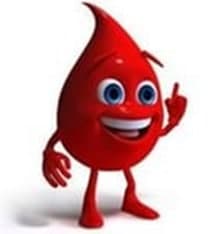
There is a scientifically proven fact - for a healthy person, blood donation is useful. This is, as it were, a shake of the body of blood loss. After all, a person is a representative of the animal world, and in the process of evolution he was adapted to lose blood from time to time. And the latter, say, 150 years thanks to scientific and technological progress, the possibilities of medicine, and improve the standard of living in general, the loss of blood has been minimized. Women physiologically lose blood once a month, but men in no way. Their body is not adapted, and the loss of a relatively small volume of blood can be dangerous. And if a person is a regular donor, then he is trained in blood circulations, and the loss of blood in emergency situations will not be so dangerous for him. In general, blood loss is a signal to the mobilization of the whole organism. All systems begin to function in conditions aimed at compensating for blood loss. And, of course, blood donation has great psychological and social value. When a person goes to this, he tunes in altruism.
 In order to fully satisfy the need of hospitals in donated blood, it is necessary that for every 1000 people to account for 40 donations per year.
In order to fully satisfy the need of hospitals in donated blood, it is necessary that for every 1000 people to account for 40 donations per year.
There are varieties of donations in which only plasma, or granulocytes are taken from the body. After such a procedure, recovery occurs faster than with ordinary donation.
According to scientists from the University of Coopio in Finland, who have observed a group of 2862 men over 40 for 9 years, regular donation reduces the risk of myocardial infarction by 88%.
 Blood groups O (I), A (II), B (III) and AB (IV) not only in people, but also in monkeys. True, our closest relatives, chimpanzees, during evolution, for some reason, lost the III and IV of blood groups, but they have the same groups of groups I and II as ours. In the first half of the twentieth century, experiments were conducted that showed that we may well be donors for each other. This is not practiced due to the danger of transmitting infections-and indeed, it is easier to find a person’s donor than a shockproken donor!
Blood groups O (I), A (II), B (III) and AB (IV) not only in people, but also in monkeys. True, our closest relatives, chimpanzees, during evolution, for some reason, lost the III and IV of blood groups, but they have the same groups of groups I and II as ours. In the first half of the twentieth century, experiments were conducted that showed that we may well be donors for each other. This is not practiced due to the danger of transmitting infections-and indeed, it is easier to find a person’s donor than a shockproken donor!
Many donors note that the bloodstream dramatically increases the mood. Most likely, this is due not only to satisfaction from a good deed, but also by the fact that blood loss is stress for the body, and under stress our brain allocates endorphins.
 In old school textbooks, the concepts of “universal donor” and “universal recipient” were used, but today in the vast majority of cases the blood of the same group is used as the recipient. The need for the blood of all groups is the same is the same. If the group is rare, this means that there are few such donors; If the group is common, then there are a lot of recipients who need such blood.
In old school textbooks, the concepts of “universal donor” and “universal recipient” were used, but today in the vast majority of cases the blood of the same group is used as the recipient. The need for the blood of all groups is the same is the same. If the group is rare, this means that there are few such donors; If the group is common, then there are a lot of recipients who need such blood.
The prevalence of different blood groups in the world:
- O (i) rh + 36%
- A (II) RH + 28%
- B (III) RH + 21%
- AB (IV) RH + 5%
- O (i) rh - 4%
- A (ii) rh - 4%
- B (III) RH - 1%
- AB (IV) RH - 1%
Head of the City Center for Transfusiology of the UZ "6th City Clinical Hospital",
Transfusiologist of the highest qualification category, candidate of medical sciences O.V. Klimovich




























